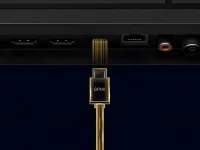Chinese companies have created a new cable standard called GPMI. More than 50 firms joined forces, including big names like Huawei, Hisense, and TCL. Their cable moves data at 192 Gbps and delivers 480 watts of power - much faster than what HDMI offers today. The small Type-C version handles 96 Gbps with 240 watts, but the larger Type-B gives you the full speed and power. Both options beat current standards by miles since HDMI 2.1 tops out at just 48 Gbps, and DisplayPort 2.1 reaches only 80 Gbps.
This third-generation link works both ways, carrying video, sound, data, and electricity through one cable. You can split its main data channel into different setups based on what you need. The system includes extra paths for managing devices, reading cable details, and even connects as USB 2.0. Chinese designers made sure the Type-C model works with USB-C stuff already out there, helping it fit into TVs and other smart gadgets. They built GPMI mainly for Chinese markets to free themselves from Western control and fees.
Regular HDMI makes companies pay up every year. Big manufacturers shell out $10,000 annually. Smaller ones pay $5,000 plus $1 per unit. Everyone pays royalties between 4 and 15 cents per device. These fees let them use the latest specs, run tests, and join promotions. GPMI breaks these chains and upgrades connection standards at the same time. The size of companies behind GPMI means we should see real products soon across China and in places that buy Chinese exports.
This cable lets you run ultra-sharp 8K screens with super-smooth refresh rates through a single connection. Its design simplifies how everything hooks up to displays. The main channel adapts to whatever you need - from 6+2 to 1+7 channel splits, depending on your setup. Media players, game systems, computers, and TVs all benefit from these fresh capabilities. Each part serves a purpose - data moves lightning fast, power flows stronger, and everything talks back and forth without extra wires.
Chinese engineers purposely built GPMI to shift away from paying Western companies for technology rights. The cable brings better features with local control. This matters because electronics makers save money they would spend on license fees and royalties. These savings might lead to cheaper products for buyers. Huawei, Hisense, and TCL will likely add these ports to their next wave of products. Before long, GPMI might appear on items shipped worldwide, changing how devices connect to screens everywhere.
This third-generation link works both ways, carrying video, sound, data, and electricity through one cable. You can split its main data channel into different setups based on what you need. The system includes extra paths for managing devices, reading cable details, and even connects as USB 2.0. Chinese designers made sure the Type-C model works with USB-C stuff already out there, helping it fit into TVs and other smart gadgets. They built GPMI mainly for Chinese markets to free themselves from Western control and fees.
Regular HDMI makes companies pay up every year. Big manufacturers shell out $10,000 annually. Smaller ones pay $5,000 plus $1 per unit. Everyone pays royalties between 4 and 15 cents per device. These fees let them use the latest specs, run tests, and join promotions. GPMI breaks these chains and upgrades connection standards at the same time. The size of companies behind GPMI means we should see real products soon across China and in places that buy Chinese exports.
This cable lets you run ultra-sharp 8K screens with super-smooth refresh rates through a single connection. Its design simplifies how everything hooks up to displays. The main channel adapts to whatever you need - from 6+2 to 1+7 channel splits, depending on your setup. Media players, game systems, computers, and TVs all benefit from these fresh capabilities. Each part serves a purpose - data moves lightning fast, power flows stronger, and everything talks back and forth without extra wires.
Chinese engineers purposely built GPMI to shift away from paying Western companies for technology rights. The cable brings better features with local control. This matters because electronics makers save money they would spend on license fees and royalties. These savings might lead to cheaper products for buyers. Huawei, Hisense, and TCL will likely add these ports to their next wave of products. Before long, GPMI might appear on items shipped worldwide, changing how devices connect to screens everywhere.












